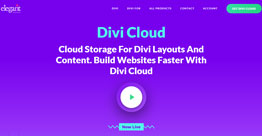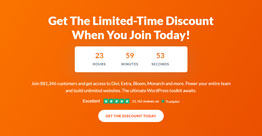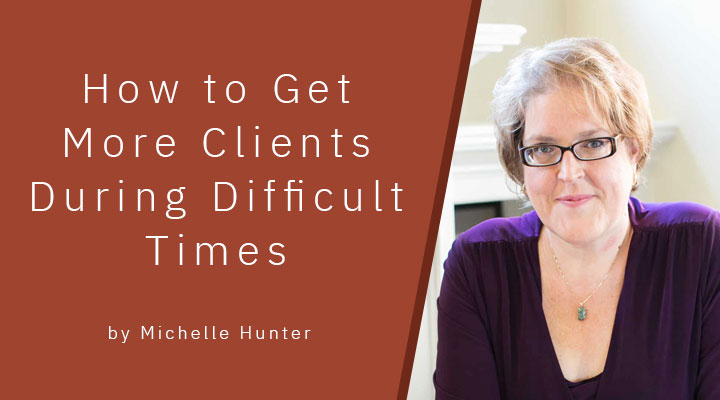The word of mouth marketing system – where previous clients tell their friends and peers about your services – often works well during normal times. In fact, many web designers I know credit word of mouth referral as their primary marketing channel.
But, during difficult times this marketing channel isn’t enough. When the money runs out and the projects end, it can be difficult to figure out what to do next to market your business.
In moments like these, it’s tempting to discount your work or quickly create some “new offer” or tempting package that just might generate enough money to get you through financially until the next project arrives. I understand, but you need to resist.
Desperation is not a winning marketing strategy. Instead, I want you to follow this plan to get yourself a few new clients – both now, and well into the future.
Simplify your marketing strategy
Marketing is – essentially – a conversation between you and your potential clients. This is true regardless of the platform, marketing channel, or method you choose to engage your audience.
Find it strange to think of marketing as a conversation? The reason for the confusion is this → You fail to factor in both sides of the dialogue. There’s always a response from your potential clients – even if you don’t hear it.
When I read your social media post, for example, I engage with it in my mind. I react internally and form an impression… even if I fail to indicate my engagement with a like or a comment.
The marketing conversation exists to make your potential clients aware of a problem, define the problem and the solution, and present yourself and your work as the ideal solution for the problem. This is marketing strategy in its simplest form, and this is how it maps out:
- You have a problem – Identify the problem in a way that your potential client can understand and feel emotionally.
- Define the problem – Make sure your potential client knows that this problem can be solved, but it’s too important to tolerate or ignore.
- Define the solution – There are often multiple solutions to a problem. Focus on the solutions that align with your services and work.
- Present YOUR solution – Talk about your work and the aspects of your business that make working with you ideal. Invite them to learn more.
The key to effective marketing is to keep everything simple. Don’t overcomplicate things – just focus on your main offer or service. For example, imagine I operate a food cart in your neighborhood. My marketing conversation with you might go like this:
- Hey friend! You look really hungry. (You have a problem.)
- Feeling hungry isn’t any fun. (Define the problem.)
- You need something quick and tasty to eat. (Define the solution.)
- I have these great street tacos. Want one? (Present solution and invite.)
Your marketing strategy can be just this simple. Chances are good that you’re overcomplicating it with fancy language or lots of extra features and add on details. Don’t do that, okay?
Instead, simplify your approach using this formula. Once you do, you’re ready for the next step.
Renew your outreach efforts
It seems pretty logical, right? Effective marketing means outreach – making sure people know about your business and your work. So, why aren’t we more consistent in our efforts to reach out to potential clients?
We have plenty of valid excuses – from lack of time and lack of clarity, to a failure to understand exactly who needs or wants our services. We look for answers to our questions before we take action… it’s simply human nature. As a result, our outreach efforts are likely pretty anemic and we rely on work that comes our way more passively.
Here’s the issue: During difficult times, passive measures don’t work as well. They fail to provide the volume of leads you need to generate consistent revenue. Unfortunately, you have to get serious about outreach if you want to attract new clients.
Want results quickly? Let’s keep this simple. Make a list of people who:
- Worked with you in the past 12 months and might need more of your magic or…
- Have contacted you in the past but for some reason weren’t quite ready yet or…
- Know you in some way and also have the problem you solve or…
- Know you really well, but don’t have a clue what you actually do.
Contact people on your list – in order of the priority I shared above – and share your conversation with them in a casual way.
What do I mean by casual? Send a quick email. Grab the phone and call them. Talk to them while you are together in person in a social setting.
Not sure what to say? Use the conversation you mapped out earlier and let it guide you. Here are some examples to get you started…
Email a former client with a message like this:
Thought of you today. When we worked on your project, you mentioned . That problem is pretty easy to solve by . I’ve got a few openings in my schedule right now. Should we get together and talk? I’d enjoy working with you again if you’re ready.
Email those who contacted you in the past but were not yet ready like this:
You contacted me in the past and mentioned . We discussed possible solutions, but the timing didn’t seem right for our work together. I have a few openings in my schedule currently, and thought it made sense to reach out to you. How has the problem changed since we last spoke?
These examples demonstrate the tactic that works the best. Reach out personally and put your simple conversation format into the context of your relationship with the potential client. Your goal is simply to start a dialogue about your work… and then the rest should flow naturally for you.
Be consistent, persistent and don’t quit
This simple marketing plan is extremely effective if you use it. When you reach out to people personally and connect with them to discuss your business in a clear and concise way, they naturally respond.
The key is to be both consistent and persistent. You can’t give in to panic or give up when you get a few negative responses. Here are some things to remember…
- The first few conversations will feel awkward. The next few will feel a bit less awkward. After that you’ll get more comfortable. But this will never be easy, you’ll always have to try.
- Many people will not be interested or ready yet. You’ll get “no” answers. That’s normal, and you should expect it.
- You only need a few new projects. If everyone on your list was ready to work with you and wanted to book a project immediately, you would likely be overwhelmed. Just one “yes” is enough.
You may get discouraged or distracted by a desire to do something complex that has worked for a colleague or peer. You may be tempted to simply complain about your situation or bury your head in the sand and ignore the problem. Resist all of this and force yourself to consistently take action.
Decide to contact five people on your list each day… or three people on the list each week… or just one person today and one tomorrow. Decide on the action you will take and then hold yourself accountable to take it. Continue taking action until you get your first yes… then you’ll be excited to try for more.
Want quick results? Be intentional and consistent.

Michelle Hunter is the founder of Michelle Hunter Creative. She provides custom marketing strategy to web designers and white label copywriting services to their clients. Elevate your Brand. Become a Strategic Partner.






































Great read Michelle. This article is very helpful to both the newcomers but also to seasoned professionals that may just need a reminder of where they started.
I look forward to reading more of what you have to offer.
Frank
Always important – especially when things feel challenging – to go back to the basics. Thanks for your comment, Frank. I look forward to sharing more in the future.
Wonderfully simple and yet seems super effective! Thanks for these words of wisdom.
Speaking effectively about your work gets easier with practice, Jools. So important to keep it simple and conversations. Thanks for your comment!
awesome. love it
Thanks, Shawn! I’m so glad it was helpful.